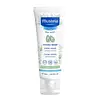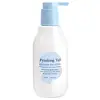What's inside
What's inside
 Key Ingredients
Key Ingredients

 Benefits
Benefits

 Concerns
Concerns

 Ingredients Side-by-side
Ingredients Side-by-side

Water
Skin ConditioningHelianthus Annuus Seed Oil
EmollientOlus Oil
EmollientGlycerin
HumectantC10-18 Triglycerides
EmollientCetyl Alcohol
EmollientPolyglyceryl-6 Distearate
Emulsifying1,2-Hexanediol
Skin ConditioningCera Alba
EmollientHydroxyethyl Acrylate/Sodium Acryloyldimethyl Taurate Copolymer
Emulsion StabilisingParfum
MaskingJojoba Esters
EmollientCaprylyl Glycol
EmollientSodium Stearoyl Glutamate
CleansingPolyglyceryl-3 Beeswax
EmulsifyingTocopheryl Acetate
AntioxidantCitric Acid
BufferingPolysorbate 60
EmulsifyingSorbitan Isostearate
EmulsifyingPersea Gratissima Fruit Extract
EmollientWater, Helianthus Annuus Seed Oil, Olus Oil, Glycerin, C10-18 Triglycerides, Cetyl Alcohol, Polyglyceryl-6 Distearate, 1,2-Hexanediol, Cera Alba, Hydroxyethyl Acrylate/Sodium Acryloyldimethyl Taurate Copolymer, Parfum, Jojoba Esters, Caprylyl Glycol, Sodium Stearoyl Glutamate, Polyglyceryl-3 Beeswax, Tocopheryl Acetate, Citric Acid, Polysorbate 60, Sorbitan Isostearate, Persea Gratissima Fruit Extract
Water
Skin ConditioningGlycerin
HumectantDipropylene Glycol
HumectantMacadamia Integrifolia Seed Oil
Skin ConditioningMethylpropanediol
SolventHydrogenated Poly(C6-14 Olefin)
EmollientPolyglyceryl-3 Distearate
EmulsifyingCaprylic/Capric Triglyceride
MaskingOctyldodecanol
EmollientSorbitan Sesquioleate
EmulsifyingButylene Glycol
HumectantAmmonium Acryloyldimethyltaurate/Vp Copolymer
Caprylyl Glycol
EmollientGlyceryl Stearate Citrate
EmollientPentylene Glycol
Skin ConditioningHydroxyacetophenone
AntioxidantHelianthus Annuus Seed Oil
EmollientCarbomer
Emulsion StabilisingTromethamine
BufferingTrehalose
HumectantHydrogenated Lecithin
EmulsifyingEthylhexylglycerin
Skin ConditioningDisodium EDTA
Tocopherol
AntioxidantPrunus Amygdalus Dulcis Oil
Skin ConditioningMoringa Oleifera Seed Oil
EmollientPersea Gratissima Oil
Skin ConditioningSimmondsia Chinensis Seed Oil
EmollientArgania Spinosa Kernel Oil
EmollientCamellia Sinensis Seed Oil
Humectant1,2-Hexanediol
Skin ConditioningCentella Asiatica Extract
CleansingGlycyrrhiza Glabra Root Extract
BleachingArtemisia Montana Leaf Extract
Skin ConditioningMacadamia Ternifolia Seed Oil
EmollientSodium Hyaluronate
HumectantVaccinium Corymbosum Fruit Extract
Skin ConditioningAnastatica Hierochuntica Extract
AstringentLonicera Japonica Flower Extract
Skin ConditioningGinkgo Biloba Leaf Extract
Skin ConditioningRosa Canina Fruit Oil
EmollientPhytosteryl/Behenyl/Octyldodecyl Lauroyl Glutamate
Skin ConditioningCholesterol
EmollientBrassica Campestris Sterols
EmollientHydrolyzed Hyaluronic Acid
HumectantHydroxypropyltrimonium Hyaluronate
Polyglyceryl-10 Oleate
Skin ConditioningPotassium Cetyl Phosphate
EmulsifyingCeramide NP
Skin ConditioningSodium Hyaluronate Crosspolymer
HumectantSodium Acetylated Hyaluronate
HumectantCeramide Ns
Skin ConditioningCeramide EOP
Skin ConditioningCitrus Aurantium Bergamia Fruit Oil
MaskingCitrus Aurantium Dulcis Peel Oil
MaskingLimonene
PerfumingLinalool
PerfumingWater, Glycerin, Dipropylene Glycol, Macadamia Integrifolia Seed Oil, Methylpropanediol, Hydrogenated Poly(C6-14 Olefin), Polyglyceryl-3 Distearate, Caprylic/Capric Triglyceride, Octyldodecanol, Sorbitan Sesquioleate, Butylene Glycol, Ammonium Acryloyldimethyltaurate/Vp Copolymer, Caprylyl Glycol, Glyceryl Stearate Citrate, Pentylene Glycol, Hydroxyacetophenone, Helianthus Annuus Seed Oil, Carbomer, Tromethamine, Trehalose, Hydrogenated Lecithin, Ethylhexylglycerin, Disodium EDTA, Tocopherol, Prunus Amygdalus Dulcis Oil, Moringa Oleifera Seed Oil, Persea Gratissima Oil, Simmondsia Chinensis Seed Oil, Argania Spinosa Kernel Oil, Camellia Sinensis Seed Oil, 1,2-Hexanediol, Centella Asiatica Extract, Glycyrrhiza Glabra Root Extract, Artemisia Montana Leaf Extract, Macadamia Ternifolia Seed Oil, Sodium Hyaluronate, Vaccinium Corymbosum Fruit Extract, Anastatica Hierochuntica Extract, Lonicera Japonica Flower Extract, Ginkgo Biloba Leaf Extract, Rosa Canina Fruit Oil, Phytosteryl/Behenyl/Octyldodecyl Lauroyl Glutamate, Cholesterol, Brassica Campestris Sterols, Hydrolyzed Hyaluronic Acid, Hydroxypropyltrimonium Hyaluronate, Polyglyceryl-10 Oleate, Potassium Cetyl Phosphate, Ceramide NP, Sodium Hyaluronate Crosspolymer, Sodium Acetylated Hyaluronate, Ceramide Ns, Ceramide EOP, Citrus Aurantium Bergamia Fruit Oil, Citrus Aurantium Dulcis Peel Oil, Limonene, Linalool
Ingredients Explained
These ingredients are found in both products.
Ingredients higher up in an ingredient list are typically present in a larger amount.
1,2-Hexanediol is a synthetic liquid and another multi-functional powerhouse.
It is a:
- Humectant, drawing moisture into the skin
- Emollient, helping to soften skin
- Solvent, dispersing and stabilizing formulas
- Preservative booster, enhancing the antimicrobial activity of other preservatives
Caprylyl Glycol is a humectant and emollient, meaning it attracts and preserves moisture.
It is a common ingredient in many products, especially those designed to hydrate skin. The primary benefits are retaining moisture, skin softening, and promoting a healthy skin barrier.
Though Caprylyl Glycol is an alcohol derived from fatty acids, it is not the kind that can dry out skin.
This ingredient is also used as a preservative to extend the life of products. It has slight antimicrobial properties.
Learn more about Caprylyl GlycolGlycerin is already naturally found in your skin. It helps moisturize and protect your skin.
A study from 2016 found glycerin to be more effective as a humectant than AHAs and hyaluronic acid.
As a humectant, it helps the skin stay hydrated by pulling moisture to your skin. The low molecular weight of glycerin allows it to pull moisture into the deeper layers of your skin.
Hydrated skin improves your skin barrier; Your skin barrier helps protect against irritants and bacteria.
Glycerin has also been found to have antimicrobial and antiviral properties. Due to these properties, glycerin is often used in wound and burn treatments.
In cosmetics, glycerin is usually derived from plants such as soybean or palm. However, it can also be sourced from animals, such as tallow or animal fat.
This ingredient is organic, colorless, odorless, and non-toxic.
Glycerin is the name for this ingredient in American English. British English uses Glycerol/Glycerine.
Learn more about GlycerinHelianthus Annuus Seed Oil is the oil derived from the seeds of a Sunflower. Sunflower seed oil is non-fragrant. It is an emollient, meaning it helps to soften the skin.
Sunflower seed oil contains many fatty acids. The fatty acids found in sunflower seeds include (from highest amount to least): linoleic acid, myristic acid, palmitic acid, stearic acid, arachidic acid, oleic acid, and linolenic acid.
These fatty acids help the skin create ceramides. Ceramides play a role in repairing the skin barrier.
Helianthus Annuus Seed Oil helps moisturize the skin. This in turn helps the skin look more rejuvenated and smoother.
Sunflowers are rich in vitamin E.
Historians believe Indigenous cultures of North America domesticated sunflowers before corn. Thus they relied on sunflower oil for a variety of uses. One such use is moisturizing skin and hair.
Sunflower seed oil may not be fungal acne safe. We recommend speaking with a professional if you have any concerns.
Learn more about Helianthus Annuus Seed OilWater. It's the most common cosmetic ingredient of all. You'll usually see it at the top of ingredient lists, meaning that it makes up the largest part of the product.
So why is it so popular? Water most often acts as a solvent - this means that it helps dissolve other ingredients into the formulation.
You'll also recognize water as that liquid we all need to stay alive. If you see this, drink a glass of water. Stay hydrated!
Learn more about Water